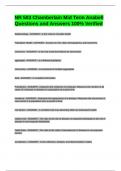NR 503 Chamberlain Mid Term Anabell
Questions and Answers 100% Verified
Epidemiology - ANSWER - is the science of public health
Population Health - ANSWER - focuses on risk, data, demographics, and outcomes.
Outcomes - ANSWER - is the end result that follows an intervention
aggregate - ANSWER - is a defined population.
community - ANSWER - is composed of multiple aggregates
data - ANSWER - is complied information
Prevalence - ANSWER - measures the existence of a disease. Measures the number of all
cases of a disease or attribute in a population at a given time
Incidence - ANSWER - measures the appearance of a disease. Measures the occurrence of
new events in a population over a period of time.
risk factors - ANSWER - a condition that may adversely affect an individual's health
relative risk - ANSWER - The ratio of the risk of disease on exposed individuals to the risk of
disease in non-exposed individuals.
Odds Ratio - ANSWER - The ratio of the odds of development of disease in non-exposed
person.
surveillance - ANSWER - is the collection, analysis, and dissemination of data.
,high-risk - ANSWER - is an increased chance of poor health outcome.
Morbidity - ANSWER - is the presence of illness in a population
mortality - ANSWER - is related to the tracking deaths in an aggregate
vital statistics - ANSWER - statistics on live births, deaths, fetal deaths, marriages and divorces.
cases - ANSWER - set of criteria used in making a decision as to whether an individual has a
disease or health event of interest
Social Justice - ANSWER - the view that everyone deserves equal rights and opportunities —
this includes the right to good health
Inter-professional collaboration - ANSWER - The idea of sharing and implies collective action
oriented toward a common goal, in this case, improving the quality and safety of patient care. It
involves responsibility, accountability, coordination, communication, cooperation, assertiveness,
mutual respect, and autonomy.
Healthy People 2020 - ANSWER - aims to reach four overarching goals: 1.Attain high-quality,
longer lives free of preventable disease, disability, injury, and premature death, 2. Achieve
health equity, eliminate disparities, and improve the health of all groups 3.Create social and
physical environments that promote good health for all. 4. Promote quality of life, healthy
development, and healthy behaviors across all life stages.
Determinants of care/health - ANSWER - The range of personal, social, economic, and
environmental factors that influence health status are known ...
risk analysis - ANSWER - the characterization of the potential adverse health effects of human
exposures to environmental hazards
health disparities - ANSWER - the difference in health statuses between various groups
(populations).
, Sensitivity - ANSWER - measures the proportion of actual positives that are correctly identified
as such (e.g., the percentage of sick people who are correctly identified as having the condition)
Specificity - ANSWER - (also called the true negative rate) measures the proportion of actual
negatives that are correctly identified as such (e.g., the percentage of healthy people who are
correctly identified as not having the condition)
Positive predictive value - ANSWER - is the probability that subjects with a positive screening
test truly have the disease
epidemiological triangle - ANSWER - 1. A traditional model of infectious disease causation,
known as the Epidemiological Triad is depicted in Figure 2. The triad consists of an external
agent, a host and an environment in which host and agent are brought together, causing the
disease to occur in the host.
confounding variable - ANSWER - is an "extra" variable that you didn't account for. They can
ruin an experiment and give you useless results. They can suggest there is correlation when in
fact there isn't. They can even introduce bias. That's why it's important to know what one is, and
how to avoid getting them into your experiment in the first place
Study Methods - ANSWER - descriptive and analytic
descriptive study AKA Natural history of disease - ANSWER - It is the first step in epidemiology
investigation. Used to describe the distribution of the disease and other health-related states
and events. Describes person place and time. Provided data for program planning, resource
planning, and generates a hypothesis. There are 4 types: correlational (ecologic) studies, case
reports, case series, and cross-sectional studies.
analytic study - ANSWER - consists of observational and experimental. Observational include
case control and cohort. Experimental includes random control trial (typically for new drug
testing), field trial (conducted on those who have a high risk of obtained a disease), and
community trial (research is conducted on an entire community or neighborhood). Test a
hypothesis.
Rapid Cycle Improvement (RCI) - ANSWER - 1. "quality improvement method that identifies,
implements and measures changes made to improve a process or a system." it implies that




